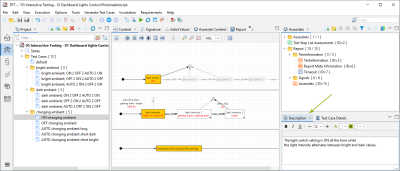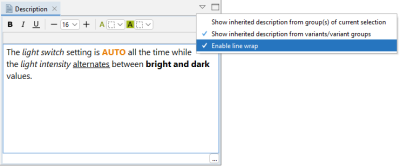Description
You can add a description to the elements visible in the Project view, that is to:
- the project name
- testlet
- variant folder
- variants
- test case folder
- test cases
It is also possible to attach files to a description. The description can be inherited to child-elements, for example the description of a test case folder can be inherited by the test cases in that folder.
Description of test case 'AUTO changing ambient long'
Select View|Show View|Description to open the Description view. Select a state, a testlet, a variant or a test case in the Project view.
The font weight can either be normal or bold, the font style can be normal or italic. Text can be underlined. The font color can be adapted by selecting another foreground color. The background color can be changed too. The font size can be set up to 20 px.
Font style in the view
To add a line break in TPT, press Enter. If Enter is programmed for another purpose then make a line break by pressing the keys Alt+Enter. For automatic line wrap, select Enable auto line wrap.
Every entry using the following syntax is automatically treated as link: http://www.xyz.uk. Instead of http://, you can also link to https://, doors://, file://, svn://, or git://. The link is clickable using Ctrl+left-click. To change the URI syntax, go to Options|Preferences|General Settings|Workbench.
Autocompletion feature in the Description view
The test specification can be generated as text to the test description of a testlet or test case, see Test Specification - Generate . Descriptions are by default not added to the report. To display descriptions in the report, see Test Report - Display Descriptions.
A test case inherits the description of a state, a variants folder or a variant, or if it is a descendant that of a test case folder. Inherited descriptions from variant/variant groups and test case/test case groups can be hidden or displayed.
The inherited description of the test case group "bright ambient" is displayed in a test case
Show inherited descriptions from group(s) of current selection
A test case inherits the description of all items it is a child of. To display the inherited description of a test case group, select this menu item. The formatting of the test case group description is not displayed.
Show inherited description from variants / variant groups
A test case inherits the description of all items of which it is a child, thus for example from a variant group and a testlet variant. To display the inherited description of a testlet variant/variant group, select this menu item. The formatting is of the variant/variant group description is not displayed.
Enable auto line wrap
Select to enable the automatic line break so all the description text is visible no matter how large or small the Description view window is.
Attachments
You can attach files that will be embedded (not linked !) to the current TPT file. You can add attachments to test cases, variants, variant groups, and test case groups. Click in the Attachments field right under the description to add attachment files; select a file and click open. Repeat the steps to add several files to the description.
You can also add files by dragging the selected attachment file into the Attachments field. Double-click the attachment file to open it. Right-click the attachment file to delete it or to save it. When dragging a selected attachment from the Attachments field to a file browser, for example the windows explorer, TPT will copy the attachment to the explorer.
file:// followed by the file path into the description field. You can also link to http://, https://, doors://, svn://, or git://. The link is clickable using Ctrl+left-click. 


